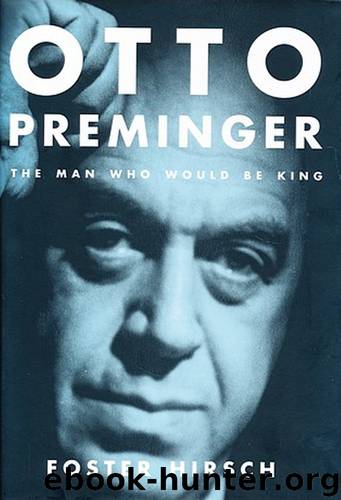Otto Preminger by Foster Hirsch

Author:Foster Hirsch [Hirsch, Foster]
Language: eng
Format: epub
ISBN: 978-0-307-48921-0
Publisher: Knopf Doubleday Publishing Group
Published: 2006-12-31T16:00:00+00:00
Anne (Deborah Kerr) looks uneasily at Cécile (Jean Seberg), the worldly young woman who will defeat her, in Bonjour Tristesse.
(1961), which also explore the alienation of the European upper bourgeoisie. The Italian films are far more ambitious than Bonjour Tristesse, but it was Preminger who first sensed the subject’s potential.
The director’s preference for wide-angle group shots gilds his chronicle of the easy life with a friezelike formality. It’s significant that when Cécile begins to feel threatened by Anne, Preminger places Cécile outside the group, hovering uncomfortably at the edge of the frame or isolated in a frame of her own. Because Preminger uses close-ups rarely, they carry a particular charge. In an early scene in a Parisian nightclub he cuts between close-ups of Cécile dancing absently with a new beau and a singer, the world-weary Juliette Greco, performing the title song; the editing enforces a comparison between Cécile, confronting her tristesse, and the melancholy torch singer. For the climactic moment in which Cécile has contrived to have Anne overhear Raymond flirting with a former paramour, Preminger keeps the camera tight on Anne with no countershot to “the lovers.” “I’ve always liked scenes where there’s no dialogue—they’re often, in film, more powerful,” recalled Deborah Kerr. “When Anne overhears the off-screen conversation, she has this awful realization that Raymond is unfaithful, and you see its impact without my saying anything. I thought it was terrific that my character’s big moment is conveyed without dialogue—just that close-up.”56
The film ends on a close-up of Jean (shot on the last day of filming, October 9, 1957, at Shepperton Studios, where the actress’s career had been launched with worldwide fanfare in January) that is a tour de force. Preminger wanted Seberg to be impassive, stripped of any readable expression, as she removes her makeup looking into a mirror. It is one of the beguiling paradoxes of this uneven, captivating film that, frozen-faced, her eyes filling with tears as Cécile faces a hollow future, Jean Seberg is intensely expressive. A cool, stylish beauty with ultra-chic, trendsetting short hair and wearing a smart black Givenchy cocktail dress, Jean Seberg in the last shot she was to make with her mentor looks like the real thing, a movie star who can also act.
In August 1958, eight months after Bonjour Tristesse bombed in America, François Moreuil persuaded Preminger to sell his contract with Jean to Columbia. “We simply had to get her out from under Otto’s thumb,” Moreuil, a lawyer, maintained.57 Preminger, however, reserved the right to use Jean in one film a year. “Otto did not think at the time, or later, that Jean had been that bad in Saint Joan,” as Hope recalled, “and he certainly would have used her again if he had had a part for her. But as it turned out he didn’t.”
Witnesses have testified to Preminger’s hard treatment of the unprepared young woman he had plucked from obscurity. He was, indeed, a demanding, impatient, and often wrathful mentor whose bullying tactics demolished her confidence.
Download
This site does not store any files on its server. We only index and link to content provided by other sites. Please contact the content providers to delete copyright contents if any and email us, we'll remove relevant links or contents immediately.
The Kite Runner by Khaled Hosseini(4416)
Gerald's Game by Stephen King(3913)
The Perils of Being Moderately Famous by Soha Ali Khan(3781)
Dialogue by Robert McKee(3575)
Story: Substance, Structure, Style and the Principles of Screenwriting by Robert McKee(2981)
The 101 Dalmatians by Dodie Smith(2931)
The Pixar Touch by David A. Price(2736)
Confessions of a Video Vixen by Karrine Steffans(2668)
Fantastic Beasts: The Crimes of Grindelwald by J. K. Rowling(2540)
How Music Works by David Byrne(2519)
Harry Potter 4 - Harry Potter and The Goblet of Fire by J.K.Rowling(2413)
Slugfest by Reed Tucker(2411)
The Mental Game of Writing: How to Overcome Obstacles, Stay Creative and Productive, and Free Your Mind for Success by James Scott Bell(2388)
Wildflower by Drew Barrymore(2114)
Scandals of Classic Hollywood: Sex, Deviance, and Drama from the Golden Age of American Cinema by Anne Helen Petersen(2104)
Casting Might-Have-Beens: A Film by Film Directory of Actors Considered for Roles Given to Others by Mell Eila(2071)
Screenplay: The Foundations of Screenwriting by Syd Field(2052)
Robin by Dave Itzkoff(2003)
The Complete H. P. Lovecraft Reader by H.P. Lovecraft(1971)
